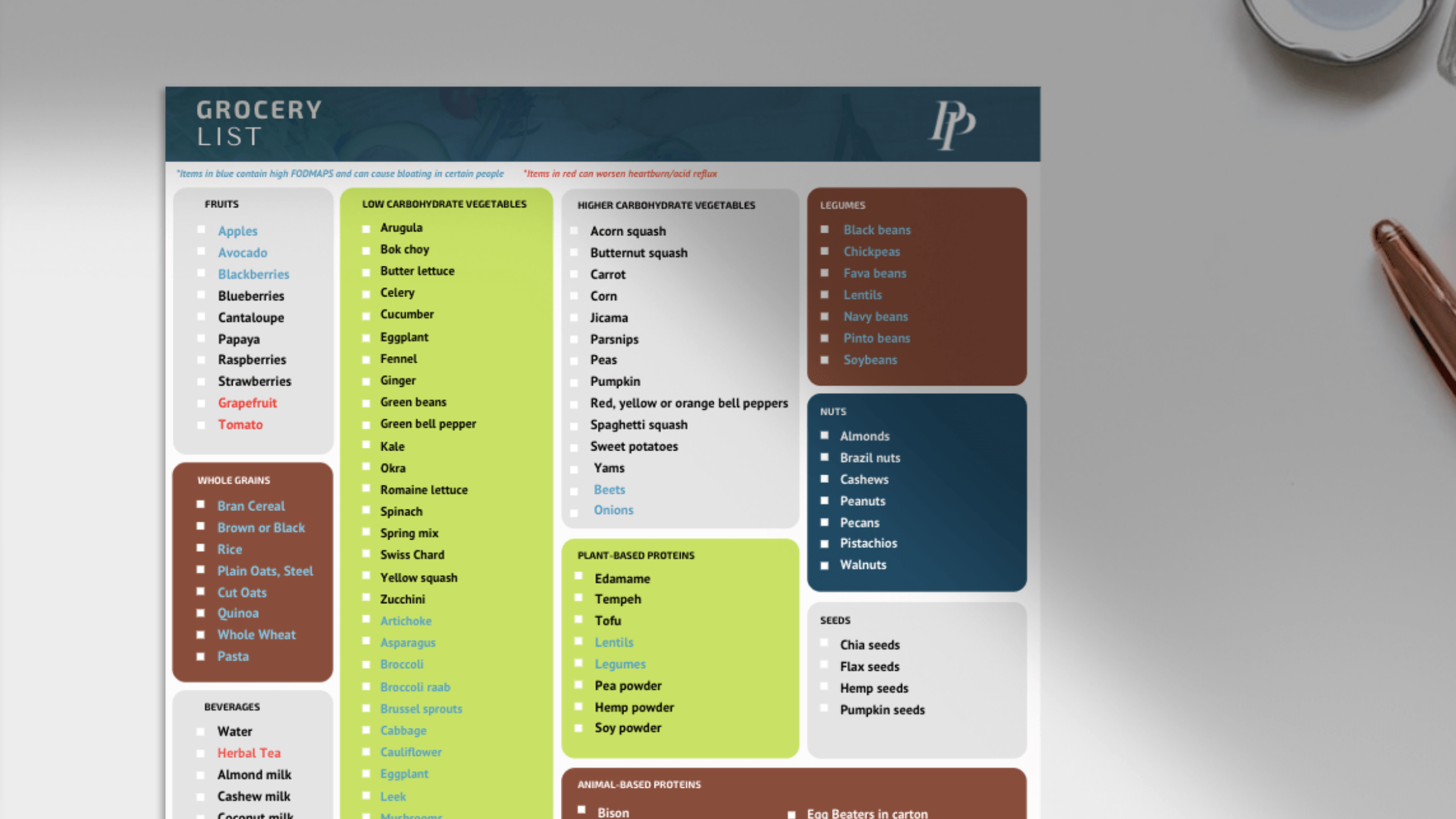Proteins
- If available and budget allows, try to choose items that are non-GMO and antibiotic and hormone free
- Fresh or Frozen options are both great
- Limit canned items unless low sodium and in water
- Limit pre-made options like cured meats and deli (high in sodium, preservatives and other cancer-causing chemicals)
- Avoid items that are stuffed, fried, or breaded
- Choose skinless options or remove skin prior to eating after item is cooked
Animal Protein Options
Eggs
- Egg beaters in carton (plain), avoid options that are flavored as they contain extra sodium
- Whole eggs
Poultry
- Choose white meat options. Dark meat contains more fat which ultimately increases the amount of calories per serving.
- Chicken breast
- Ground chicken or ground turkey, lean or extra lean
- Turkey breast
Red Meat
- Choose grass fed options, lean or extra lean, or any sort of loin
- Bison
- Sirloin
- Tenderloin
- Venison
Seafood
- Choose wild caught options
- Fish
- Salmon, cod, Mahi Mahi, halibut, snapper, ahi tuna
- Shrimp
- Calamari
- Squid
- Canned tuna or salmon are fine but choose ones that are in water and low sodium
Animal-based protein powders (Whey, casein, egg)
- Choose powders that contain minimal ingredients (aim for seven or less) and that do not contain artificial sweeteners i.e. sucralose, aspartame
Plant-based protein options
- Edamame
- Tempeh (plain)
- Tofu (plain)
- Lentils
- Legumes
- Plant-based protein powders (i.e. pea, hemp)
- Choose powders that contain minimal ingredients (aim for seven or less) and that do not contain artificial sweeteners i.e. sucralose, aspartame
Starches
- Limit highly refined options like white bread, pasta and rice
- Choose whole grains (contain more dietary fiber)
- Bran cereal, plain (no added sugar i.e. honey or dried fruit)
- Brown or black rice
- Plain oats, steel cut oats
- Quinoa
- Whole wheat pasta
- Be wary of “vegetable pastas” like spinach or chickpea pasta. Although they contain more fiber and protein than white or wheat pasta, they often contain just as many total carbohydrates
Produce
Fruits
- Choose lower sugar options
- Pick the smallest items (1 large apple is often 2-3 servings). Instead choose the smallest apples as they are often closer to 1 serving
- Fruits that taste sweeter, are sweeter (they contain more sugar). Examples include cherries, grapes, bananas, watermelon, mango and pineapples
- Apples
- Avocado
- Blackberries
- Blueberries
- Cantaloupe
- Papaya
- Raspberries
- Strawberries
- Grapefruit
- Tomato
Vegetables
Lower carbohydrate options
- Arugula
- Bok choy
- Butter lettuce
- Celery
- Cucumber
- Eggplant
- Fennel
- Ginger
- Green beans
- Green bell pepper
- Kale
- Okra
- Romaine lettuce
- Spinach
- Spring mix
- Swiss Chard
- Yellow squash
- Zucchini
- Artichoke
- Asparagus
- Broccoli
- Broccoli raab
- Brussel sprouts
- Cabbage
- Cauliflower
- Eggplant
- Leek
- Mushrooms
Higher carbohydrate options
- Acorn squash
- Butternut squash
- Carrot
- Corn
- Jicama
- Parsnips
- Peas
- Pumpkin
- Red, yellow or orange bell peppers
- Spaghetti squash
- Sweet potatoes (contain more nutrients than white potatoes)
- Yams
- Beets
- Onions
Legumes
- Great source of plant-based protein and dietary fiber
- Choose fresh (raw) or frozen
- Limit canned unless in water
- Choose low sodium options if canned
- Make sure to limit to 1 serving as they contain more carbohydrates:
- Black beans
- Chickpeas
- Fava beans
- Kidney beans
- Lentils
- Navy beans
- Pinto beans
- Soybeans (edamame)
Nuts
Choose unsalted, raw, or nut butters
Avoid nuts that are coated in salt, sugar, candied, chocolate or yogurt coated. Roasted nuts often contain additional oils that increase the total calories
Choose nut butters with no added sugar (many popular brands have cane sugar or high fructose corn syrup added)
Some grocery stores have freshly ground peanut or almond butter which is a great option but do not last as long
Almonds
Brazil nuts
Cashews
Peanuts
Pecans
Pistachios
Walnuts
Seeds
Chia seeds
Flax seeds
Hemp seeds
Pumpkin seeds
Dairy
Avoid cow’s milk (most people become lactose intolerant as we get older) and contains 12 grams of sugar per serving or more (even lactose free milk)
Be strategic with your dairy. Choose options that are nutrient dense and lower in calorie
Avoid/limit flavored yogurts as they either contain added sugars or artificial sweeteners
Choose non-dairy unsweetened milk options as an alternative to cow’s milk
Plain cottage cheese (regular or lactose free options)
Plain Greek yogurt
Beverages
Avoid beverages with added sugar, juice concentrate, and artificial sweeteners
Water
Unsweetened herbal teas (if you suffer from heartburn, limit caffeine and flavored teas with mint/peppermint
Lower carbohydrate non-dairy milk options
- Almond
- Cashew
- Coconut
- Higher carbohydrate non-dairy milk options
- Hemp
- Oat
- Soy
Cooking/Baking Ingredients
- Avoid seasonings with salt and added sugar
- Salt is salt is salt. No significant difference between white, pink, sea salt, kosher salt, or Himalayan salt. All can contribute to water retention and high blood pressure. In general, main difference is that they each contain different minerals
- Use fresh herbs for flavor
- Avoid added sugars found in most processed food and baked goods (i.e. cane sugar, sucrose, brown sugar)
- Limit sweeteners (especially artificial sweeteners like aspartame and sucralose)
- Not enough data to support proposed health claims on plant-based sweeteners (stevia, monk fruit)
- Allspice
- Basil
- Bay leaves
- Cilantro
- Cinnamon
- Coriander
- Cumin
- Nutmeg
- Nutritional yeast
- Oregano
- Paprika
- Rosemary
- Sage
- Tarragon
- Thyme
- Turmeric
- Cayenne pepper
- Mint
- Garlic and onion (avoid if you suffer from bloating and/or diarrhea as they are high FODMAP and produce gas)
Cooking oils
Specific one to use will depend on the mode of food preparation as they have different cooking temperatures.
Oil is a pure fat, so just because avocado is a plant-based oil, excessive amounts still increase the caloric content of foods.
Avocado oil great for high heat cooking (saute)
Olive oil is ideal for medium heat, great for salad dressings


